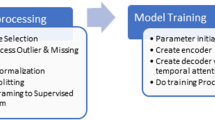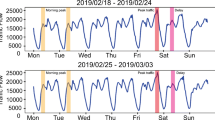Abstract
Accurate and real-time traffic flow prediction is crucial in intelligent transportation systems (ITS), and the traditional shallow prediction methods are challenging to capture the nonlinearity and uncertainty of traffic data effectively. To this end, this paper proposes a hybrid deep-learning method based on Residual Self-Attention and Bidirectional Gated Recurrent Unit combined with a Convolution-Gated Recurrent Unit (RSAB-ConvGRU) network to improve the accuracy of traffic flow prediction. The method consists of an RSA-ConvGRU module and two Bidirectional GRU (Bi-GRU) modules. The RSA-ConvGRU module includes a convolution-gated recurrent unit (Conv-GRU) module and a residual self-attention mechanism (RSA) module. Specifically, the Conv-GRU utilizes the convolutional and gated recurrent unit to extract spatial and temporal features. Moreover, the residual self-attention mechanism is used to determine the contribution of traffic features at different periods and stabilize the network’s training process to improve Conv-GRU’s prediction performance. Finally, the Bi-GRU module obtains the periodic characteristics and forward and backward variance trends in traffic flow data. The experimental results show that the accuracy of the RSAB-ConvGRU method is superior to state-of-the-art methods, such as SVR, LSTM, GRU, DCRNN, CNN-GRU-Attention, Conv-LSTM, AT-Conv-LSTM, Stacked-LSTM, and LSTM-RNN with Attention. Compared to the above nine methods, with a prediction time of 60 minutes and the urban traffic data, the MAPE values of RSAB-ConvGRU are reduced by 56.01%, 22.97%, 25.64%, 16.55%, 7.57%, 11.11%, 12.58%, 7.64%, and 6.3%, respectively.














Similar content being viewed by others
Data Availibility Statement
The datasets generated during and analysed during the current study are available from the corresponding author on reasonable request.
References
Awad M, Khanna R (2015) Support vector regression, in: Efficient Learning Machines, Springer, pp 67–80
Belhadi A, Djenouri Y, Djenouri D, Lin JCW (2020) A recurrent neural network for urban long-term traffic flow forecasting. Appl Intell 50:3252–3265
Bengio Y, Simard P, Frasconi P (1994) Learning long-term dependencies with gradient descent is difficult. IEEE Trans Neural Netw 5:157–166
Cai L, Zhang Z, Yang J, Yu Y, Zhou T, Qin J (2019) A noise-immune Kalman filter for short-term traffic flow forecasting. Physica A: Statistical Mechanics and Its Applications 536:122601
Chen X, Wu S, Shi C, Huang Y, Yang Y, Ke R, Zhao J (2020) Sensing data supported traffic flow prediction via denoising schemes and ANN: a comparison. IEEE Sensors J 20:14317–14328
Cho K, van Merriënboer B, Gulcehre C, Bahdanau D, Bougares F, Schwenk H, Bengio Y (2014) Learning phrase representations using RNN Encoder–Decoder for statistical machine translation, in: Proceedings of the 2014 Conference on Empirical Methods in Natural Language Processing (EMNLP), Association for Computational Linguistics, Doha, Qatar pp 1724–1734
Djenouri Y, Belhadi A, Lin JCW, Cano A (2019) Adapted k-nearest neighbors for detecting anomalies on spatio-temporal traffic flow. IEEE Access 7:10015–10027
Djenouri Y, Belhadi A, Chen HC, Lin JCW (2022) Intelligent deep fusion network for urban traffic flow anomaly identification. Comput Commun 189:175–181
Djenouri Y, Belhadi A, Srivastava G, Lin JCW (2023) Hybrid graph convolution neural network and branch-and-bound optimization for traffic flow forecasting. Futur Gener Comput Syst 139:100–108
Djenouri Y, Belhadi A, Lin JCW, Djenouri D, Cano A (2019) A survey on urban traffic anomalies detection algorithms, IEEE Access vol 7 p 12192–12205
Du S, Li T, Gong X, Horng SJ (2020) A hybrid method for traffic flow forecasting using multimodal deep learning. Int J Comput Intell Syst 13:85–97
Duan Y, Kang W, Li Z, Wang FY (2014) Traffic flow prediction with big data: A deep learning approach. IEEE Trans on J Intell Transp Syst 16:865–873
Emami A, Sarvi M, Asadi Bagloee S (2019) Using Kalman filter algorithm for short-term traffic flow prediction in a connected vehicle environment. Journal of Modern Transportation 27:222–232
Fu R, Zhang Z, Li L (2016) Using LSTM and GRU neural network methods for traffic flow prediction, in: 31st Youth Academic Annual Conference of Chinese Association of Automation (YAC), IEEE, p 324–328
Ghanim MS, Muley D, Kharbeche M (2022) ANN-based traffic volume prediction models in response to COVID-19 imposed measures. Sustainable Cities and Society 81:103830
Giraka O, Selvaraj VK (2020) Short-term prediction of intersection turning volume using seasonal ARIMA model. Transportation Letters 12:483–490
Gu Y, Lu W, Qin L, Li M, Shao Z (2019) Short-term prediction of lane-level traffic speeds: A fusion deep learning model. Transp Res C: Emerg Technol 106:1–16
Habtemichael FG, Cetin M (2016) Short-term traffic flow rate forecasting based on identifying similar traffic patterns. Transportation Research Part C: Emerging Technologies 66:61–78
Hu H, Lin Z, Hu Q, Zhang Y (2021) Attention mechanism with spatial-temporal joint model for traffic flow speed prediction. IEEE Trans Intell Transp Syst. 23:16612–16621
Hu X, Liu T, Hao X, Lin C (2022) Attention-based Conv-LSTM and Bi-LSTM networks for large-scale traffic speed prediction, J Supercomput p 1–24
Khajeh Hosseini M, Talebpour A (2019) Traffic prediction using time-space diagram: A convolutional neural network approach. Trans Res Rec 2673:425–435
Kolen JF, Kremer SC (2001) Gradient flow in recurrent nets: The difficulty of learning longterm dependencies, A Field Guide to Dynamical Recurrent Networks p 237–243
Kumar PB, Hariharan K et al (2022) Time series traffic flow prediction with hyper-parameter optimized arima models for intelligent transportation system, Journal of Scientific and Industrial Research 81 p 408–415
Lin X, Huang Y (2021) Short-term high-speed traffic flow prediction based on ARIMA-GARCH-M model. Wirel Pers Commun 117:3421–3430
Liu Y, Zheng H, Feng X, Chen Z (2017) Short-term traffic flow prediction with Conv-LSTM, in: 9th International Conference on Wireless Communications and Signal Processing (WCSP), IEEE, pp 1–6
Li Y, Yu R, Shahabi C, Liu Y (2018) Diffusion convolutional recurrent neural network: Data-driven traffic forecasting, Int Conf Learn Represent 00 (ICLR)
Luo J (2020) Short-term traffic flow prediction method in bayesian networks based on quantile regression. Promet-Traffic & Transportation 32:821–835
Meng M, Toan TD, Wong YD, Lam SH (2022) Short-term travel-time prediction using support vector machine and nearest neighbor method. Transp Res Rec, p 03611981221074371
Mondal MA, Rehena Z (2022) Stacked lstm for short-term traffic flow prediction using multivariate time series dataset. Arab J Sci Eng 47:10515–10529
Moniruzzaman M, Maoh H, Anderson W (2016) Short-term prediction of border crossing time and traffic volume for commercial trucks: A case study for the Ambassador Bridge. Transp Res C: Emerging Technologies 63:182–194
Nagaraj N, Gururaj HL, Swathi BH, Hu YC (2022) Passenger flow prediction in bus transportation system using deep learning. Multimedia Tools and Applications 81:12519–12542
Nie L, Jiang D, Yu S, Song H (2017) Network traffic prediction based on deep belief network in wireless mesh backbone networks, in: 2017 IEEE Wireless Communications and Networking Conference (WCNC), IEEE, p 1–5
Poonia P, Jain V, Short-term traffic flow prediction: using LSTM, in: 2020 International Conference on Emerging Trends in Communication, Control and Computing (ICONC3), IEEE, pp 1–4
Priambodo B, Ahmad A, Kadir RA (2021) Spatio-temporal K-NN prediction of traffic state based on statistical features in neighbouring roads. J Intell & Fuzzy Syst 40:9059–9072
Ren C, Chai C, Yin C, Ji H, Cheng X, Gao G, Zhang H (2021) Short-term traffic flow prediction: A method of combined deep learnings. J Adv Transp 2021:1–15
Sha S, Li J, Zhang K, Yang Z, Wei Z, Li X, Zhu X (2020) RNN-based subway passenger flow rolling prediction. IEEE Access 8:15232–15240
Shu W, Cai K, Xiong NN (2022) A short-term traffic flow prediction model based on an improved gate recurrent unit neural network. IEEE Transactions on Intelligent Transportation Systems 23:16654–16665
Shu W, Cai K, Xiong NN, (2021) A short-term traffic flow prediction model based on an improved gate recurrent unit neural network. IEEE Trans Intell Transp Syst
Sun B, Cheng W, Goswami P, Bai G (2018) Short-term traffic forecasting using self-adjusting k-nearest neighbours. IET Intell Transp Syst 12:41–48
Thaduri A, Polepally V, Vodithala S (2021) Traffic Accident Prediction based on CNN Model, 2021 5th International Conference on Intelligent Computing and Control Systems (ICICCS) p 1590–1594
Toan TD, Truong VH (2021) Support vector machine for short-term traffic flow prediction and improvement of its model training using nearest neighbor approach. Transp Res Rec 2675:362–373
Vaswani A, Shazeer N, Parmar N, Uszkoreit J, Jones L, Gomez AN, Kaiser Ł, Polosukhin I (2017) Attention is all you need, Advances in Neural Information Processing Systems vol 30
Wang J, Deng W, Guo Y (2014) New Bayesian combination method for short-term traffic flow forecasting. Transp Res C: Emerg Technol 43:79–94
Wu Y, Tan H, Qin L, Ran B, Jiang Z (2018) A hybrid deep learning based traffic flow prediction method and its understanding. Transp Res C: Emerg Technol 90:166–180
Xia D, Wang B, Li H, Li Y, Zhang Z (2016) A distributed spatial-temporal weighted model on MapReduce for short-term traffic flow forecasting. Neurocomputing 179:246–263
Xia D, Zhang M, Yan X, Bai Y, Zheng Y, Li Y, Li H (2021) A distributed WND-LSTM model on MapReduce for short-term traffic flow prediction. Neural Comput & Applic 33:2393–2410
Xia D, Yang N, Jiang S, Hu Y, Li Y, Li H, Wang L (2022) A parallel NAW-DBLSTM algorithm on Spark for traffic flow forecasting. Neural Computing and Applications 34:1557–1575
Xia D, Yang N, Jian S, Hu Y, Li H (2022) SW-BiLSTM: a Spark-based weighted BiLSTM model for traffic flow forecasting, Multimedia Tools and Applications p 1–26
Xie DF, Fang ZZ, Jia B, He Z (2019) A data-driven lane-changing model based on deep learning. Transp Res C: Emerg Technol 106:41–60
Xu H, Jiang C (2020) Deep belief network-based support vector regression method for traffic flow forecasting. Neural Comput & Applic 32:2027–2036
Xu X, Jin X, Xiao D, Ma C, Wong SC (2021) A hybrid autoregressive fractionally integrated moving average and nonlinear autoregressive neural network model for short-term traffic flow prediction. J Intell Transp Syst vol 0 p 1–18
Yang D, Li S, Peng Z, Wang P, Wang J, Yang H (2019) MF-CNN: traffic flow prediction using convolutional neural network and multi-features fusion. IEICE Trans Inform Syst 102:1526–1536
Yu C, Lam KC (2014) Applying multiple kernel learning and support vector machine for solving the multicriteria and nonlinearity problems of traffic flow prediction. J Adv Transp 48:250–271
Yu Y, Si X, Hu C, Zhang J (2019) A review of recurrent neural networks: LSTM cells and network architectures. Neur Comput 31:1235–1270
Zhang W, Yu Y, Qi Y, Shu F, Wang Y (2019) Short-term traffic flow prediction based on spatio-temporal analysis and CNN deep learning. Transportmetrica A: Trans Sci 15:1688–1711
Zhang J, Wang Y, Long M, Wang J, Wang H (2020) Predictive recurrent networks for seasonal spatiotemporal data with applications to urban computing. Chin J Comput 43:286–302
Zheng H, Lin F, Feng X, Chen Y (2021) A hybrid deep learning model with attention-based Conv-LSTM networks for short-term traffic flow prediction. IEEE Trans Intell Trans Syst 22:6910–6920
Zhu Z, Peng B, Xiong C, Zhang L (2016) Short-term traffic flow prediction with linear conditional Gaussian Bayesian network. J Adv Transp 50:1111–1123
Acknowledgements
This work described in this paper was supported in part by the National Natural Science Foundation of China (Grant nos. 62162012, 62173278, and 62072061), the Science and Technology Support Program of Guizhou Province, China (Grant no. QKHZC2021YB531), the Natural Science Research Project of Department of Education of Guizhou Province, China (Grant nos. QJJ2022015 and QJJ2022047), and the Scientific Research Platform Project of Guizhou Minzu University, China (Grant no. GZMUSYS[2021]04).
Author information
Authors and Affiliations
Corresponding author
Ethics declarations
Conflicts of interest
The authors declare that there are no conflicts of interest regarding the publication of this paper.
Additional information
Publisher's Note
Springer Nature remains neutral with regard to jurisdictional claims in published maps and institutional affiliations.
Rights and permissions
Springer Nature or its licensor (e.g. a society or other partner) holds exclusive rights to this article under a publishing agreement with the author(s) or other rightsholder(s); author self-archiving of the accepted manuscript version of this article is solely governed by the terms of such publishing agreement and applicable law.
About this article
Cite this article
Xia, D., Chen, Y., Zhang, W. et al. RSAB-ConvGRU: A hybrid deep-learning method for traffic flow prediction. Multimed Tools Appl 83, 20559–20585 (2024). https://doi.org/10.1007/s11042-023-15877-x
Received:
Revised:
Accepted:
Published:
Issue Date:
DOI: https://doi.org/10.1007/s11042-023-15877-x




